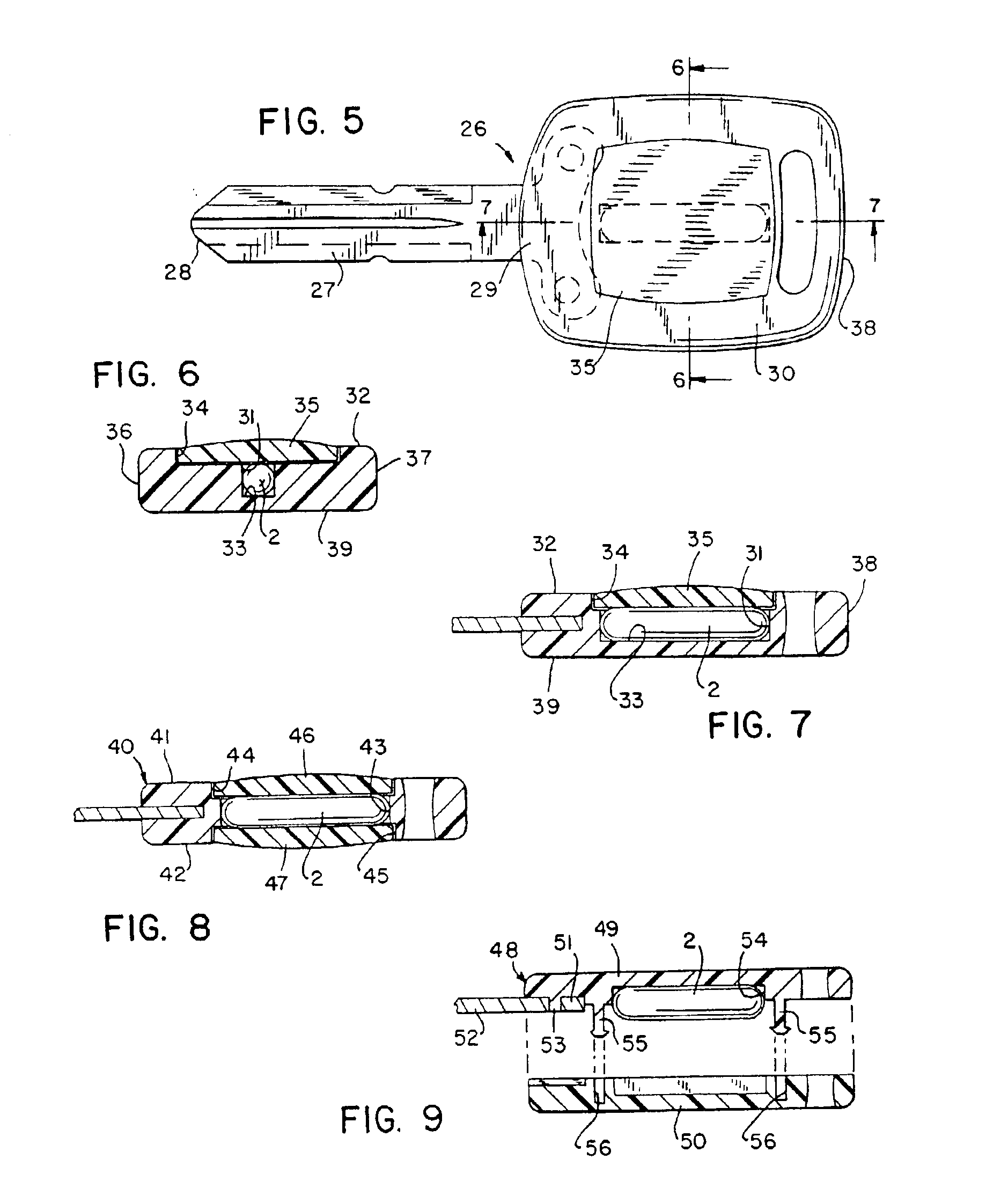Key assembly for vehicle ignition locks
a technology for ignition locks and keys, applied in the field of automotive security systems, can solve problems such as affecting the operation of rfid security systems, failure of transponders, and weakening the strength of signals sent to receivers, so as to reduce the potential for damage, prevent the application of impact forces, and reduce the effect of impact force applied
- Summary
- Abstract
- Description
- Claims
- Application Information
AI Technical Summary
Benefits of technology
Problems solved by technology
Method used
Image
Examples
first embodiment
[0121]Referring now to FIGS. 2-4, there is illustrated a first embodiment for mounting the transponder 2 in the key head 5 of the key assembly 4. As shown, the key assembly 4 includes an elongated shank 15 having a toe end 16 and a heel end 17. The key head 5 preferably is integrally coupled to the heel end 17 of the shank 15 with pins 18 formed while the key head 5 is molded. As best shown in FIG. 3, the transponder 2 is mounted in a bore 19 formed in the key head 5. The bore is dimensioned to receive the transponder and a plug 20 is adapted to close off the bore 19. The bore 19 includes a blind end adapted to engage the transponder and an open end which opens to one end of the key head 5. As best shown in FIG. 3, the blind end of the bore 19 is spaced from the heel end 17 of the shank 15 and the longitudinal axis of the bore 19 is preferably aligned with the elongated shank 15. As shown, the bore 19 opens to the rear end of the key head 5. Alternatively, the open end of the bore 1...
second embodiment
[0122]FIGS. 5-7 illustrate the key assembly of the present invention wherein the key assembly 26 includes the shank 27 having the toe end 28 and the heel end 29, and the key head 30 constructed of a plastic material integrally molded on the heel end 29 in the same manner as illustrated and described in FIG. 3. In this alternative embodiment, however, the transponder 2 is mounted within an opening comprising a substantially T-shaped recess 31 formed in one side 32 of the key head 30. The recess 31 is dimensioned to substantially correspond with the dimensions of the transponder 2. Additionally, a cushioning material, such as a silicone compound, may be supplied in the recess 31 at the time the transponder is installed. The recess 31 preferably has a closed bottom end 33 and an open top end 34 which opens to the side 32 of the key head 30. FIG. 6 illustrates the plug 35 which is preferably an adhesive-backed panel member which covers the transponder 2 and is received within the open t...
third embodiment
[0123]Yet the present invention is illustrated in FIG. 8. The key assembly of FIG. 8 is substantially similar to the key assembly of FIGS. 5-7, however, the opening which receives the transponder 2 extends completely through the key head 40 from one side 41 to the opposite side 42. As best shown in FIG. 8, the opening formed in the key head 40 includes a central section 43 for receiving the transponder 2 and a pair of opposite outer sections 44, 45 opening to opposite sides 41, 42, respectively, of the key head 40. A cushioning material such as a silicone compound may also be supplied in the central section 43 when the transponder 2 is installed. In this embodiment, the plugs 46, 47 for the openings extending through the key head 40 comprises a pair of adhesive-backed plugs 46, 47 received by the outer sections 44, 45 for covering the openings in the key head 40 such that the transponder 2 is positioned between the plugs 46, 47. The plugs 46, 47 of preferred embodiments of the prese...
PUM
 Login to View More
Login to View More Abstract
Description
Claims
Application Information
 Login to View More
Login to View More - R&D
- Intellectual Property
- Life Sciences
- Materials
- Tech Scout
- Unparalleled Data Quality
- Higher Quality Content
- 60% Fewer Hallucinations
Browse by: Latest US Patents, China's latest patents, Technical Efficacy Thesaurus, Application Domain, Technology Topic, Popular Technical Reports.
© 2025 PatSnap. All rights reserved.Legal|Privacy policy|Modern Slavery Act Transparency Statement|Sitemap|About US| Contact US: help@patsnap.com



